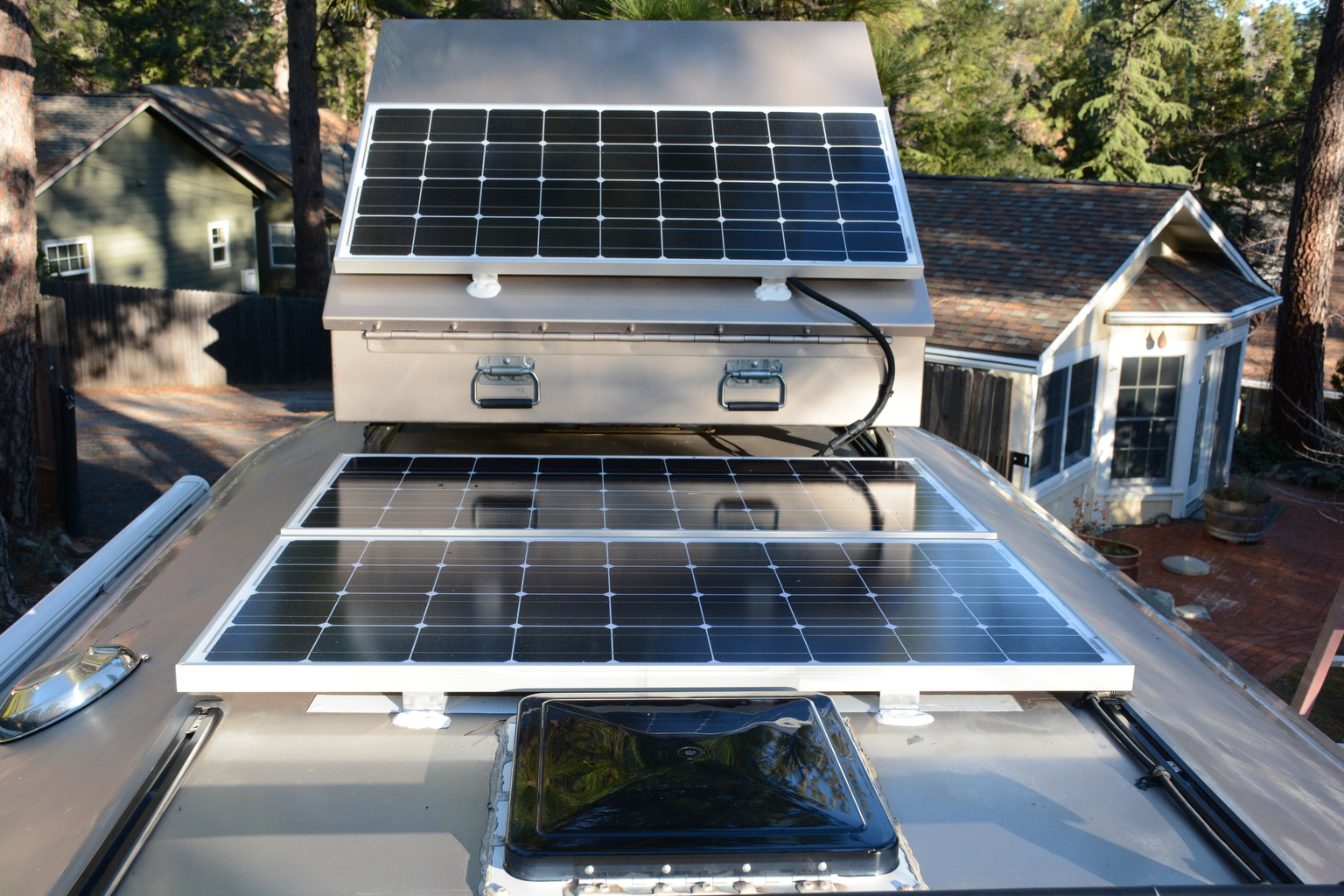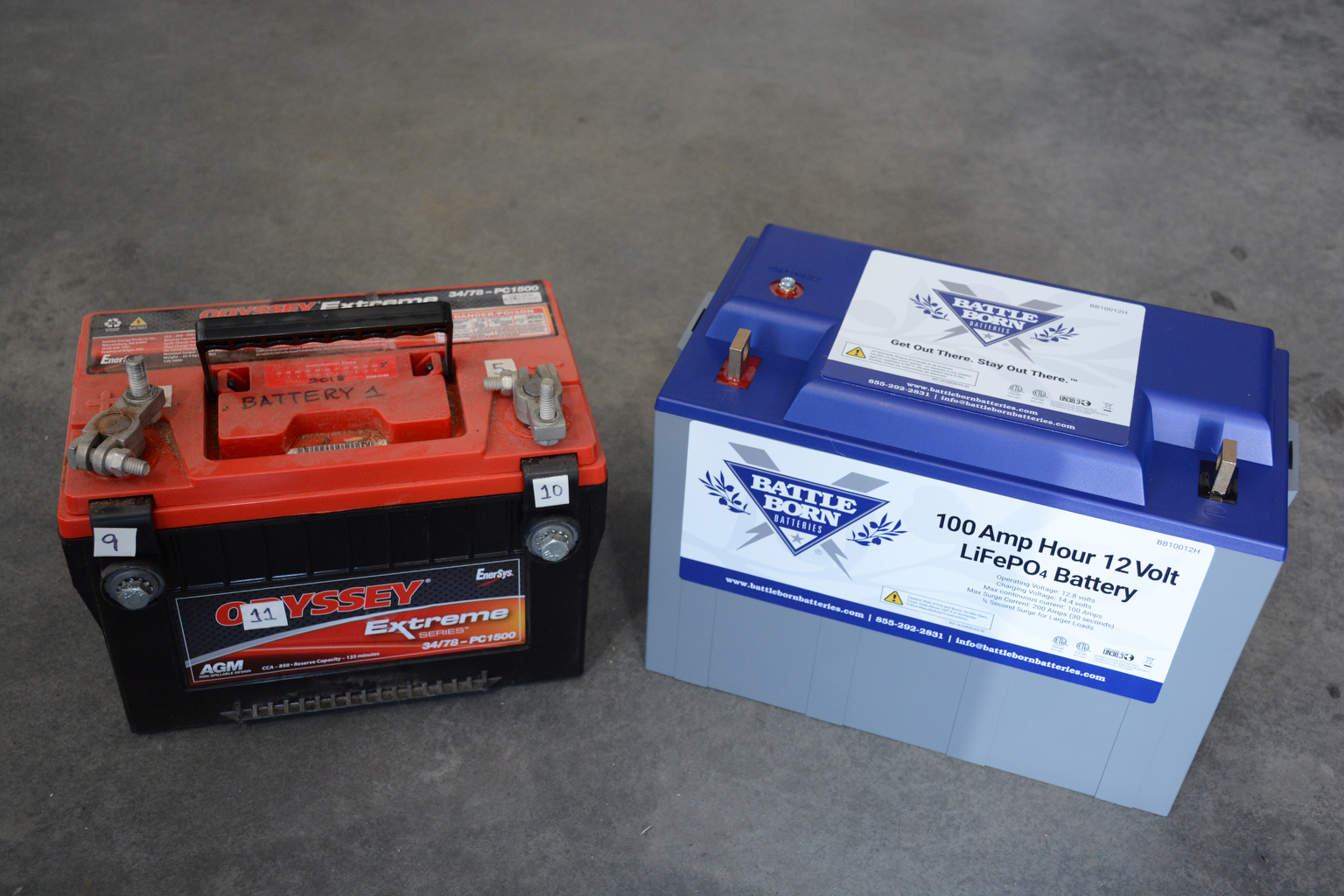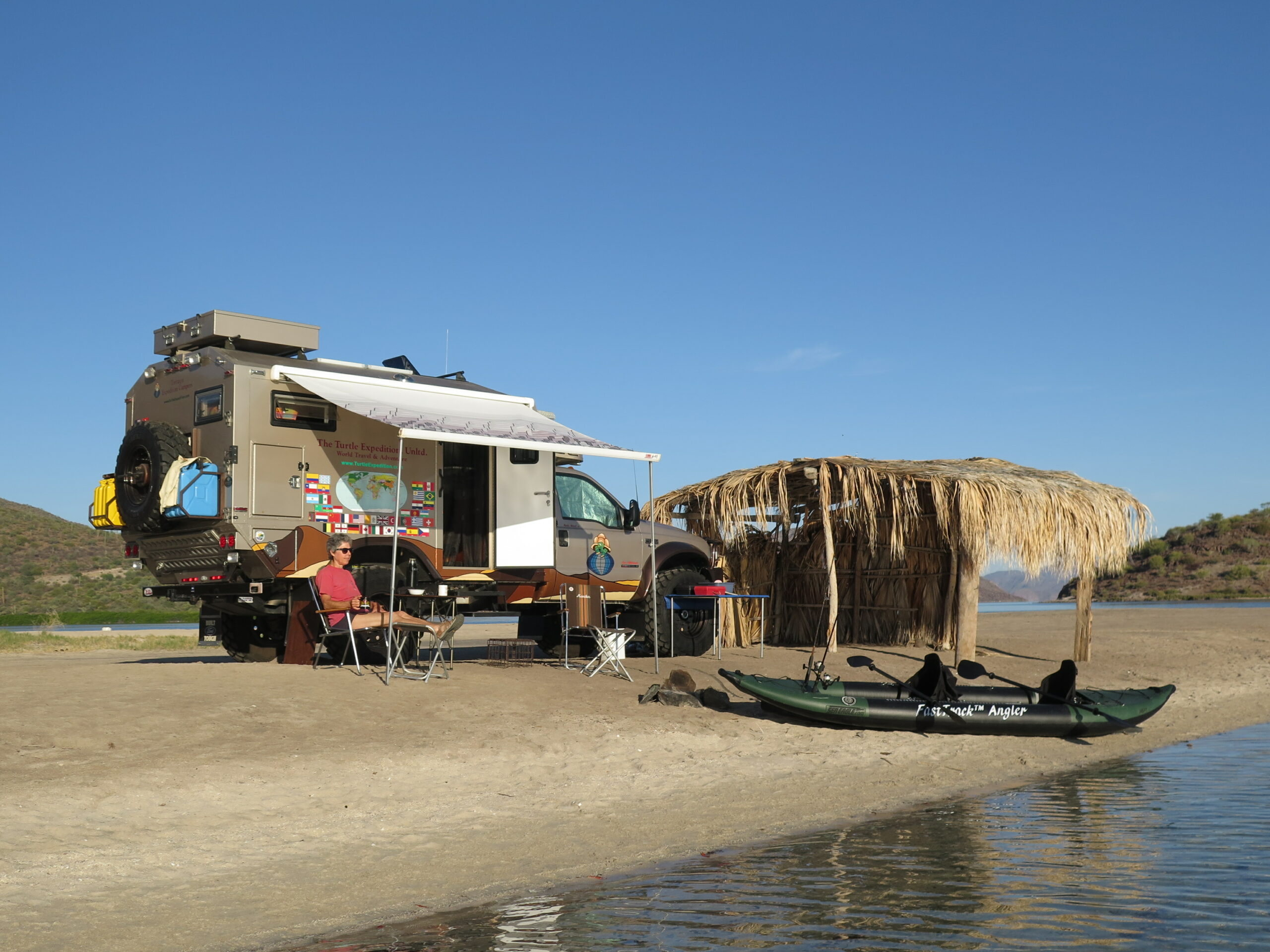Think back to 1972. Some of you may remember when The Turtle Expedition, Unltd. was exploring the backroads of Mexico and Central America in our trusty 1967 109 Land Rover. At that time, we had one battery, and its functions were to start the 6-cylinder gas engine (that choked on Mexican Pemex Nova regular), turn on the single dome light, and power the little 12-volt oscillating fan over the windshield, the essence of our air-conditioning at night. During the day, the two big vents under the windshield that will be familiar to those who know Land Rovers were adequate for keeping us cool, along with the sliding side windows (not electric or rollup).

Fast forward 50 years, and you’ve probably noticed that overland travel has gotten very popular. Monika and I have been given part of the credit for introducing it to readers, and while it’s still exciting to explore the same back roads, I guess we outgrew the “roughing it” part.
Accessories like water pumps, heaters, multiple interior lights, compressor refrigerators, air compressors, and a couple dozen other conveniences that today need reliable 12-volt DC power (occasionally, converted 120-volt AC power) have certainly made life on the road of adventure more comfortable and sometimes even safer.
As we prepare The Turtle V for its next adventure in South America, having driven the same truck 40,000 miles around the world already, we decided it was time to completely update our aging solar power and energy system, including batteries and the various accessories that allow them to work together.
The assortment of items on this table came out of our expedition truck, and almost everything has a battery that needs to be charged, including cameras, computers, flashlights, a printer, and even an electric toothbrush. Got a dog? How about a 12-volt vacuum cleaner? Remember the last time you spilled half a cup of white rice on the floor?

If you want to go super deluxe (and maybe you already have), you could add a microwave oven, an induction stove, an electric coffee pot, and air-conditioning. Some Unicat Expedition Vehicles campers made in Germany even have a washer and dryer for clothes. We don’t know everything, but after traveling around the world for almost 50 years, we have opinions of what’s important to us. Thanks to the global interest in the pursuit of overland travel and ongoing technological advancement, new products available today are (at least) amazing.
Back in the Land Rover days, we had an ice chest. One of our first lessons was when you fill a cooler full of ice, there’s no room for food. Welcome to compressor refrigerators that don’t use propane or need to be level all the time. Unless you have shore power, they will need juice from a battery bank. And probably more than one battery and solar panels if you’re camped on a remote beach in Baja for a week and still want a cold one in the evening or if you happen to be camped at 15,272 feet in the mountains of Tajikistan and you want the camper’s heater and hot water system to work.
At the 2022 Overland Expo in Bend, Oregon, we were fortunate to meet KP Pawley, owner of Zero Declination in Reno, Nevada, not too far from our home. The shop specializes in converting overland vehicles to modern solar power and upgrading their antiquated AGM/lead acid batteries to what is now the standard for overland vehicles: lithium. KP and his assistant, Zac, are masters of 12-volt solar and lithium battery conversions. It is not uncommon to see two or three Four-Wheel Campers pop-ups and a van undergoing an electrical upgrade in their shop, and the results are impressive. We decided to put The Turtle V in their hands.
This article is not a DIY outline but instead reflects the conclusions reached, products selected, and installation processes observed during our upgrade. For your own build needs, do some careful research to determine which products would best suit your needs. If you are not an experienced electrician, save time and money and find a reputable shop that can install the products correctly—the first time. Our job rolled in at approximately $14,000. Zero Declination advised us that smaller rigs without complex inverter systems are typically in the $5,000 range, while larger rigs, more complex systems, or a project from scratch can cost as much as $20,000 or more.

To gain extra solar power, a third Go Power 100-watt panel was installed on top of our rear storage box.
If you are savvy enough to manage the installation, you will need special tools and parts. Basic materials should include several feet of black and red 4/0 battery cables, a selection of 4/0 copper lugs and a crimping tool, a foot or so of 4/0 heat shrink tubing, and quality electrical wire in the gauges you might need. Wire size is determined by the largest potential system draw or charge source.
You should also have a supply of solderless heat shrink terminals like the ones made by Quick Cable, wire stripping and crimping pliers, a small torch to finish off the heat shrink terminals, a multimeter, and electrical tape if you aren’t using solderless heat shrink terminals. If you don’t want to spend the money (around $100) on a 4/0 copper battery terminal lug crimper, Quick Cable makes copper 4/0 fusion solder lugs that are equally as effective, but they do require a torch to melt the solder as you insert the wire into the lug. For a professional installation, we noticed that Zac carefully measured the length of each 4/0 cable and ensured copper lugs were oriented to match the vertical copper battery posts.

Individual connections to the fused switches on our Blue Sea AC/DC power control board were carefully measured using QuickCable solderless terminals.
To begin with, by swapping our two aging BP 85-watt solar panels for three Go Power (owned by Dometic) 100-watt panels, we basically jumped from 170 watts to 300 watts, even on a cloudy day. Yes, solar panels do wear out. Our old BP panels that had served us well were made of polycrystalline cells that typically start to age after five years. The new highly efficient Go Power panels are made of monocrystalline cells, which greatly increase their ability to convert sunlight into electricity. They are encapsulated between a special tempered, low-iron, solar high transmissivity tempered glass with a Tedlar/polyester backing material.

Basic install materials include several feet of black and red 4/0 battery cables, a selection of 4/0 copper lugs and a crimping tool, 4/0 heat shrink tubing, and quality electrical wire in the gauges determined by the largest potential system draw or charge source.
The Go Power mounting frame is manufactured from an anodized, marine-grade aluminum, allowing the panels to tolerate extreme conditions like 135°F in the desert of Turkmenistan, -70°F in Siberia, or a week-long salty beach camp. Each panel includes four mounting legs that provide better circulation wherever they are attached. Our GP-BF-100M kit came with a plug-and-play junction box and industry-standard quick disconnect cables (MC4) that permit them to work in series or in parallel. They come with a 25-year limited power output warranty.
Looking for more solar power, we had a third GP-BF-100M panel installed, mounted on top of our rear storage box. After the installation, we noticed an unplanned bonus. If we happen to be camped with the camper parked pointed toward the rising or setting sun, by simply lifting the lid on the storage box, we gain much more direct solar power from that third panel. If we need to remove the storage box, KP added a quick-disconnect plug on the third panel.

A good selection of shrink-to-fit solderless terminal connectors like those made by QuickCable are also necessary for install.
The Go Power kit comes with a 29-page set of detailed instructions in English, provided you are fluent in “electrical talk.” The Go Power panels are available in a variety of sizes and capabilities. In our case, the 100-watt panels were the same dimensions as the BP panels installed on the top of our expedition camper for 200,000 miles.
Of course, there are days when the sun never shines, and we still need to recharge the batteries. To compensate for those conditions, we ordered our F-550 7.3L Power Stroke engine with Ford’s Ambulance Package that includes dual alternators. A single 135-amp alternator with a standard internal regulator charges the starting batteries for the engine, and the second alternator, rated at 200 amps, is controlled by using a Balmar remote marine regulator that charges only the camper batteries. The Balmar can be programmed for the voltage required by the type of batteries we are using. In preparation for our next adventure in South America, both alternators were bench-checked, and bearings and brushes were replaced.


The next stage of any quality solar panel installation is the addition of a solar controller, which takes the electrical energy from the solar system and converts it into usable 12-volt power at a controlled rate to charge your storage batteries. In the past, we had used a Solar Boost 2000E. It was replaced with the new, much improved Blue Sky SB3000i controller. Fortunately, it was the same size, so no modifications to our electrical control panel were needed. To our advantage, since we had previously used solar panels on this camper, some of the wiring could be reused after being inspected by the experts at Zero Declination.
The SB3000i controller features fully automatic or manual equalization. It has 15 programmable perimeters to accommodate any battery style or chemistry, including lithium. On the SB3000i control panel, we can set up absorption voltage, absorption time, float voltage, and even a temperature compensation factor, all at a glance on the LED screen. Most of these settings will depend on how many solar amps your panels produce and what type of batteries you use. While all these settings sound confusing, we don’t worry about them once they are set. What we mainly want to see is battery voltage, input and output current, and total amp hours charged.
That brings us to a new subject. Where and how will we store all the power we are getting from the solar panels and our auxiliary alternator? Batteries are like a reservoir. In the past, we have always relied on high-quality AGM batteries, but after listening to experts, it became obvious that the modern solution was to go with lithium batteries. Zero Declination recommended Dragonfly Energy (also based in Reno) and its Battle Born lithium batteries. The company designs and assembles their lithium batteries in-house, giving them ultimate quality control. Aside from being the perfect size to fit in our designated battery storage compartment, we were able to replace four AGM batteries, weighing almost 50 pounds each, with just three Battle Born BB10012 100 Amp 12-volt batteries that weigh only 31 pounds each—maybe not too critical for our truck suspension, but it’s 100 fewer pounds we have to carry around.

The Blue Sky Energy SB3000i charge controller features fully automatic or manual equalization and has 15 programmable parameters to accommodate any battery style or chemistry, including lithium.
The Battle Born lithium batteries are rated at 100 amp hours each. Our old AGMs were rated only at 68 amp hours (actually 34 amp hours because only 50 percent is usable). By replacing them, we doubled the amount of power storage available. Unlike AGM batteries, the Battle Borns can use full-rated amperage until they automatically shut down. They also have some interesting features, such as a built-in battery management system (BMS) and an internal heating system that can be turned on if you expect temperatures lower than 27°F. Regardless of colder temperatures, they will continue to discharge normally but cannot take a charge. If the BMS detects the voltage falls below 10.5 volts, it disconnects the battery to prevent damage. It also includes protection from high voltage and short circuits. These BB10012 batteries are rated for 3,000-5,000 cycles and come with a 10-year warranty. A complete instruction booklet shows the tools you need and the best way to install the batteries.


We’ve all heard about electric vehicles catching on fire on the side of the freeway because of lithium batteries, a serious concern that Dragonfly Energy has addressed. Their batteries use lithium iron phosphate, a chemistry that is much more stable and robust, unlike older Tesla units that previously used nickel cobalt aluminum chemistry, which is comparatively unstable.
Now that our 12-volt power is safely stored, we wanted a way to control and direct it to where it was needed and keep the system charged. By installing an inverter/charger combination, we will be able to charge the batteries if we are plugged into shore power, or it will convert from 12 volts to 120 volts when needed. We chose the Victron MultiPlus Compact, a vast improvement over our antiquated Xantrex Prosine 2.0 inverter/charger. The battery bank supplies 12-volt power to our Blue Sea circuit board which contains individual breakers for every electrical outlet in the camper, including lights, the water pump, heaters, the doorstep, 12-volt plugs, and USB plugs.

The Victron MultiPlus Compact inverter/charger combination was a vast improvement over our antiquated Xantrex Prosine 2.0 inverter/charger.
The MultiPlus can supply on-demand 120-volt AC power to our multiple outlets for any accessory batteries we might be recharging. If we are plugged into shore power, the Victron automatically begins charging the house batteries at a specifically controlled rate. Should there be a sudden external power failure, it instantly switches to inverter mode to keep everything running that requires AC voltage. The microprocessor-driven adaptive battery management system can be adjusted to various types of batteries. Whether that system is receiving shore power or only solar, when the batteries reach their maximum charge level, the Victron automatically switches to a maintenance mode and prevents overcharging.

Our Blue Sea AC/DC power control board circuit contains individual breakers for every electrical outlet in the camper, including lights, the water pump, heaters, the door step, 12-volt and 110-volt plugs, and USB plugs.
Zero Declination also installed a BMV-712 Smart Battery Monitor. This Bluetooth device can be customized to show battery voltage, the rate of amps being used at the moment, and amps remaining in the system, and it will tell us the percentage of charge the battery bank is holding. All these features can be monitored with an app on our cell phone or via the small round display screen.

The microprocessor-driven adaptive battery management system of the Victron MultiPlus Compact’s control panel allows us to adjust various types of batteries when the system is receiving shore power or only solar.
The Turtle V is now powered up for an adventure in South America, regardless of the weather or location. Imagine us camped in the middle of the Salar de Atacama, the largest salt flat in Chile (we visited once before, in 1988). If we were tech-crazy, which we are not, while lying in bed, I could say, “Alexa, please play Vivaldi on our Sony stereo system and turn the electric coffee pot on. Apple’s Siri has already told me exactly when the sun will come up at our location.” Our Eberspächer Airtronic heater is purring in the background. I grab a cup of hot coffee and step outside to watch the sunrise creep over the distant snowcapped Andes as it melts over the altiplano in the distance. Walking out into the crisp morning air, the crystallized salt under our feet crackles like a bowl of Rice Krispies. Our only company is a small flock of pink flamingos a few yards away, probably feeding on the brine shrimp that inhabit the small pools of water that percolate up from the subterranean lake we’re parked on. We don’t even have to get dressed because the nearest other vehicle or person is at least 20 miles away. We are overlanding, and we’re still roughing it. Where are you going next?
Resources
Go Power gopowersolar.com
QuickCable quickcable.com
Balmar balamar.net
Dragonfly Energy dragonflyenergy.com
Sunforge LLC sunforgellc.com
EnerSys enersys.com
Victron Energy B.V. victronenergy.com
Eberspächer eberspaecher-na.com
Blue Sea Systems bluesea.com
Zero Declination zerodeclination.com
Editor’s Note: This article was originally published in Overland Journal’s Gear 2024 Issue.
Our No Compromise Clause: We do not accept advertorial content or allow advertising to influence our coverage, and our contributors are guaranteed editorial independence. Overland International may earn a small commission from affiliate links included in this article. We appreciate your support.
Read more: A Place in the Sun :: Comparing 8 Solar Panels for Overlanding by Richard Giordano


